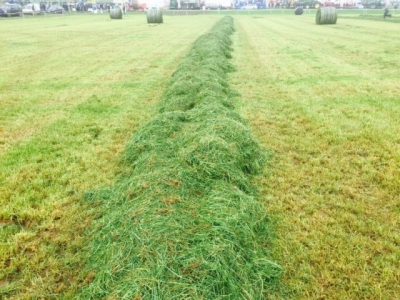Cutting silage? Heres how to make the neighbours jealous with your quality silage

The silage season has kicked into gear with farmers taking advantage of the good weather to make the coming winter’s feed.
But, research shows that the feeding value will be linked to the quality of the grass and the steps taken during mowing, wilting and preserving.
1. Cutting Date Impacts On Quality
Teagasc research shows that the feeding value of silage is linked to the amount of leaf and stem present in the sward.
It shows that delayed cutting has a negative impact on the silage quality, as the Dry Matter Digestibility declines by 2.5-3 units for every week delay in harvest between late May and mid June.
It advises farmers to monitor the growth of the sward during May and June and to mow when seed heads start to emerge from the grass.
The quality of silage needed will vary, it shows, as finishing cattle will require a silage DMD of 72% or greater, while 65% DMD silage is fine for spring calving suckler cows.

2. Grass Sugar Levels
The sugar content of the grass is important to ensure the silage crops are preserved properly, according to Teagasc research.
It says that the sugar content of the grass is more important that the Nitrogen content, as the crop will preserve easily if the sugar content of the grass is 3% or higher.
The sugars are highest in grass on bright sunny days with cool nights, it shows and if a crop is low in sugar it can be resolved by wilting, adding molasses or acid.
3. Mowing
Farmers should only mow grass for silage if the weather allows for harvesting and ensiling to be completed, it advises.
The best time to mow grass for silage is when the grass is dry after the morning dew has gone of the grass.
This is because it is easier to dry the dew of a standing grass crop.
Farmers should also avoid soil contamination of the silage, because this can result in poor preservation and reduced feed quality.

4. The Importance Of Wilting
Wilting the grass makes the sugars more concentrated in the grass, it says, which makes it easier to preserve the crop.
Ideally crops should be wilted for 24-36 hours prior to bailing or putting it in the pit, however, this can be challenging in broken weather conditions.
Teagasc advises farmers to wilt their silage to a dry matter of 30% when bailing and 25% for pit, drying it more than 30% will not give any improvement in animal performance.

Sealing The Pit
The pit needs to be filled and sealed quickly to ensure that the harvested crop is kept free from air to aid preservation, it says.
It also advises farmers to pay particular attention to compacting the pit and it suggests that farmers should ask the contractor to roll the pit well to help remove air, which helps to preserve the silage.

Related news
 Tips for reducing personal injury on dairy farms
Tips for reducing personal injury on dairy farms Dairy farm employees need to be aware of their surroundings at all times and implement safety practices and procedures.
 Will dairy cows eat their hydroponic sprouts?
Will dairy cows eat their hydroponic sprouts? US researchers are evaluating the impact of integrating hydroponic feeds, such as sprouted barley, into the diets of dairy heifers and lactating cows.
 Calf intestinal health linked to long-term performance
Calf intestinal health linked to long-term performance Calf gut health research needs to be part of a larger understanding of calf development, not an isolated study, as it can have lasting influence